Mexico Bucket List: 25 Amazing Experiences You Need To Have
Mexico is widely known for its majestic beaches spread along 9000+ km of coastline. However, this glorious, vibrant country has so much more to offer than just sun and sand! Throughout Mexico you’ll find gorgeous colonial cities, stunning natural scenery, some of the best food you could imagine ever tasting, fascinating remnants of ancient civilizations, and so, so, so much more.
I’ve compiled this Mexico Bucket List with the help of some fellow travel bloggers in order to show you just how many different types of experiences there are to be had in Mexico. There’s truly something here for all types of travelers from thrifty backpackers, to luxury seekers, art and history fanatics, foodies, and beyond!
Full disclosure: After spending over 3 years living in Mexico, my bucket list has only gotten longer! I haven’t yet had the opportunity to partake in ALL the experiences featured here, which is why I asked my fellow travel bloggers to share their experiences! I will keep adding experiences to this collection as I continue to travel and learn about Mexico and Mexican culture.
If you think I’ve left out something crucial drop a comment below, or send me an email and I’ll add it to my list of things to do in Mexico!
Related Reading
- Is Mexico Safe For Solo Female Travelers?
- 32 Essential Mexico Travel Tips You Need to Know
- 20 Essential Spanish Phrases for Mexico
Northern Mexico & the Baja Peninsula
From wine regions of Ensenada and snorkeling reefs off of Los Cabos, the arid landscapes of the Sonoran desert, the famous Copper Canyon in the state of Chihuahua, Northern Mexico, and the Baja Peninsula offer plenty to explore!
1. Sea Kayaking Along the Baja Peninsula
The Baja Peninsula has long been a draw for adventure travelers who venture south in search of sun and sand. Surfing, diving, fishing, and whale watching are all popular activities in the Baja, especially toward the southern tip of the peninsula.
Sea Kayaking is another fantastic way to appreciate the stunning nature of this region. There are all kinds of sea kayaking expeditions available, some lasting for a few hours and others for a few days.
Leigh, of Campfires and Concierges, recently tried a multi-day Sea of Cortez kayaking expedition that departed from La Paz, Baja California Sur. The tour included visits to sea lion colonies by kayak, as well as snorkeling excursions, all from a beautiful basecamp on Isla Espiritu near La Paz.
If you’re looking for an adventurous way to experience nature in Baja California, definitely check out a sea kayaking tour.
Read Also: 14 Adventurous Outdoor Experiences in Mexico
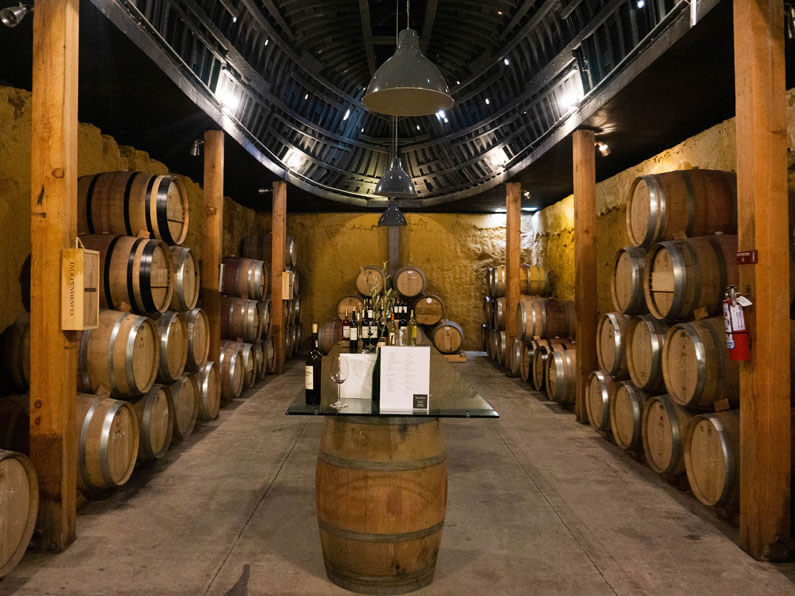
2. Wine Tasting in Valle de Guadalupe, Baja California
By Chris of Explore Now Or Never – follow her on Pinterest for more travel inspiration!
Wine tasting in Mexico? Yes indeed! Definitely add a few days of wine tasting in Valle de Guadalupe to your Mexico bucket list. With more than 75 wineries, this valley’s unique Mediterranean climate—warm days and breezy nights—has inspired varietals from around the world…everything from syrah and cabernet to tempranillo and chardonnay!
Just a two-hour drive from San Diego east of Ensenada, it’s easy to do a day trip to Valle de Guadalupe, either on your own or with a tour. Or stay a few nights with one of the dozens of eco-friendly hotels, B&Bs, or Airbnbs around the valley.
Mix up your tasting itinerary at wineries in Valle de Guadalupe by visiting some of the older, more established wineries (there’s a handful that have been making wines for decades) with some of the up-and-coming boutique wineries. Wines aren’t inexpensive here (plan on $25 USD per bottle and on up) but you can find some memorable wines.
The food scene here is also on the rise. Whether you want a budget (gourmet) meal at a food truck or are ready to splurge on a four-course food and wine pairing, you won’t be disappointed.
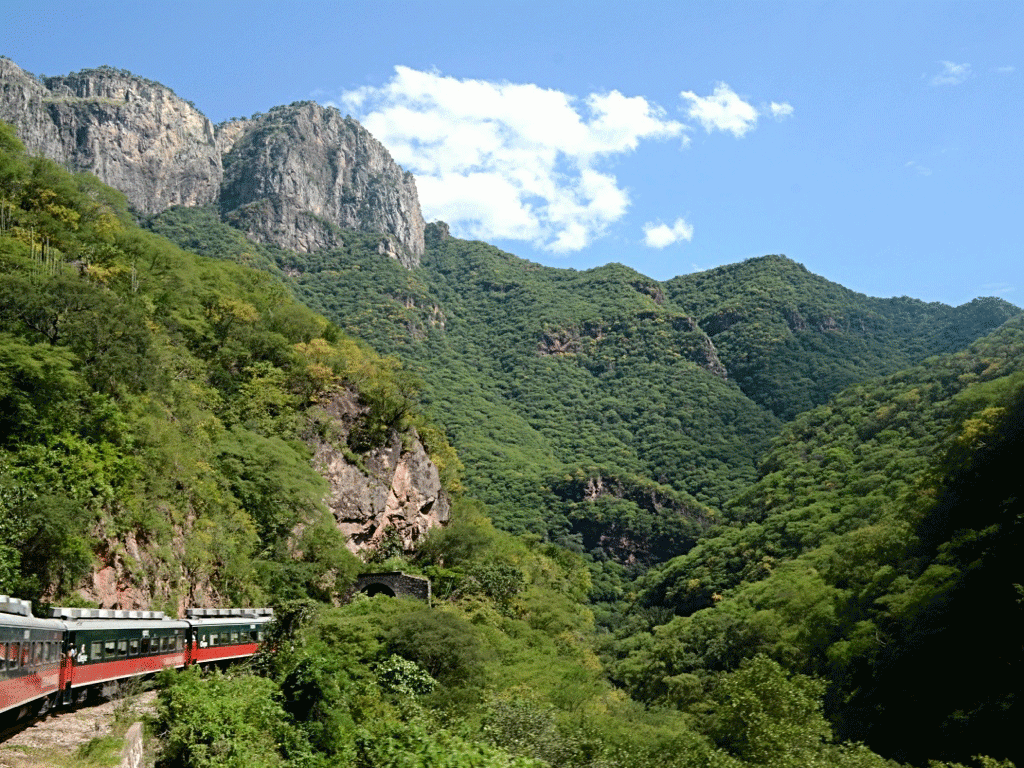
3. Ride “El Chepe” Train through Copper Canyon, Chihuahua
Copper Canyon, or La Barranca del Cobre as it is known in Spanish, is a system of canyons that are both bigger and deeper than the famed Grand Canyon of the US (not that Mexico is bragging).
One of the most popular ways to experience Copper Canyon is via the famous “El Chepe” train, which travels from the city of Chihuahua (in Chihuahua state) to Los Mochis, Sinaloa. The views are supposedly fantastic from the train, and I’m dying to see them for myself!
According to Trip Savvy, the 400-mile journey through Copper Canyon includes 36 bridges, more than 80 tunnels, and an 8000-foot elevation gain! The train makes a couple of stops along the way which enables passengers to take day hikes, visit viewpoints, and explore villages along the route. If any of the stops are particularly intriguing to you, you can even arrange to stop over for a night or so and catch the train again afterward!
Central Mexico
Central Mexico includes the states of Aguascalientes, Colima, Estado de Mexico, Guanajuato, Guerrero, Hidalgo, Jalisco, Michoacan, Morelos, Nayarit, Queretaro, San Luis Potosi, Tlaxcala, and Zacatecas.
This region is incredibly varied because it features the sun-soaked beach towns of the west coast, the lush jungles of the coastal mountains, the arid terrain and colonial cities of the central valley and central highlands, and more!
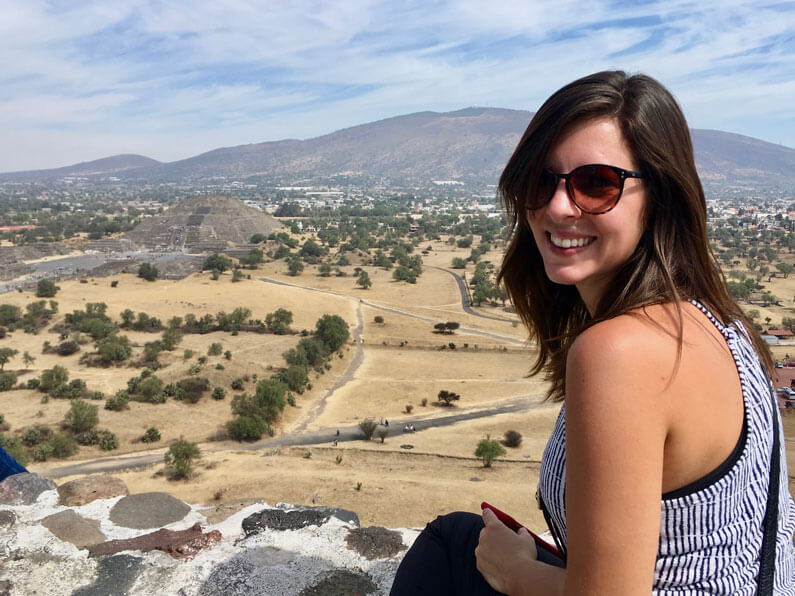
4. Climb the Pyramid of the Sun at Teotihuacán
The Mesoamerican city of Teotihuacán is just an hour outside of Mexico City. Just as Mexico City is one of the largest cities in the Americas, with 21.2 million people, Teotihuacán was one of the largest cities of pre-Columbian Americas, with a population of 125,000.
Experts believe the site dates back to 100 B.C. and was in use until the 8th Century AD. The history of the site is curious because it was known to have been inhabited by the Aztecs, but the city was already in ruins by the time they arrived to inhabit it. Who built and inhabited this location prior to the Aztecs is a subject of much debate.
Teotihuacán is most famous for the pyramids of the Sun and the Moon, the Sun being the 3rd largest pyramid in the world. While the landmarks are stunning, the visit is much more dynamic when led by a guide who can explain the historical relevance of each of the structures.
This archaeological site makes an easy day trip from Mexico City. Pack plenty of water and apply sunscreen, as shade is non-existent, and it is bound to be hot.
Related Reading: Incredible Ruins in Mexico You Should Visit
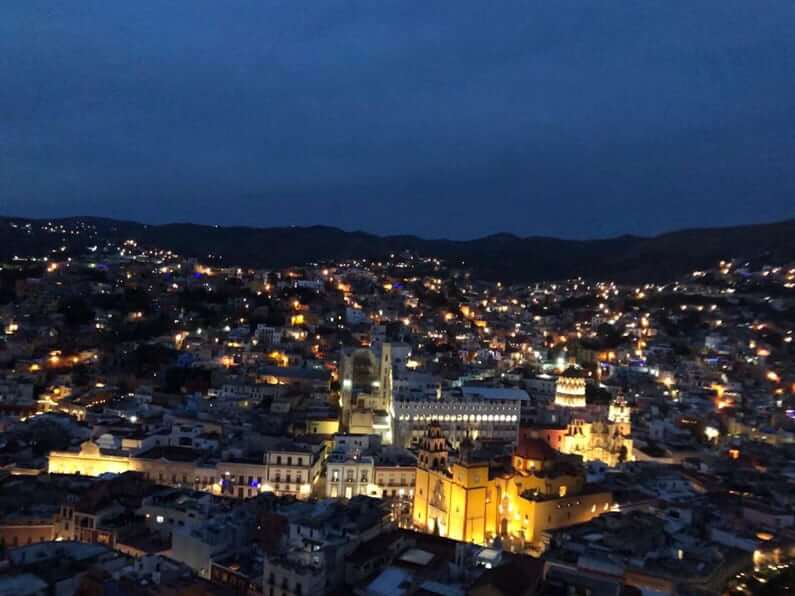
5. Experience Dia de Muertos or Cervantino Festival in Guanajuato City, Guanajuato
By Erika of Latin Atlas
When someone is ready to explore Mexico beyond the beach, Guanajuato City is my first recommendation. After visiting 26 of 31 Mexican states over the course of a lifetime, Guanajuato is a stand-out.
A UNESCO World Heritage Site, it’s a colorful and festive walkable colonial town carved into a mountainous ravine. Bursting with plazas, gardens, narrow alleyways (known as callejones), cobblestone streets, markets, cafes, and other wonders, it’s the perfect backdrop for one of Latin America’s most famous arts festivals, Festival Cervantino.
As you’ve probably surmised, its namesake is the famous 16th-century writer, Miguel de Cervantes. The two-and-a-half-week festival’s packed with visitors from around Mexico and the world enjoying both ticketed and free, indoor and outdoor music and other art performances.
Occurring every October, the festival coincides with the lead-up to Día de Muertos on November 1 and 2, elevating the festival with new and old Day of the Dead traditions.
Enjoy pan de muerto (a sweet bread), a city full of catrinas (people wearing skulled-painted faces and “19th-century” dresses), yellow, orange and scarlet marigolds, and similar flowers and market stands selling calaveras (skulls made out of various materials both edible and not).
Guanajuato City is an easy bus ride from Mexico City, Guadalajara, Querétaro, and San Miguel de Allende. The city is bustling from the beginning of Cervantino in early October through Three Kings’ Day on January 6. I’ve visited 4 times (2 for El Cervantino) during this period and have always been able to find a room last minute. Enjoy the festival!
Click here to discover more incredible things to do in Guanajuato!
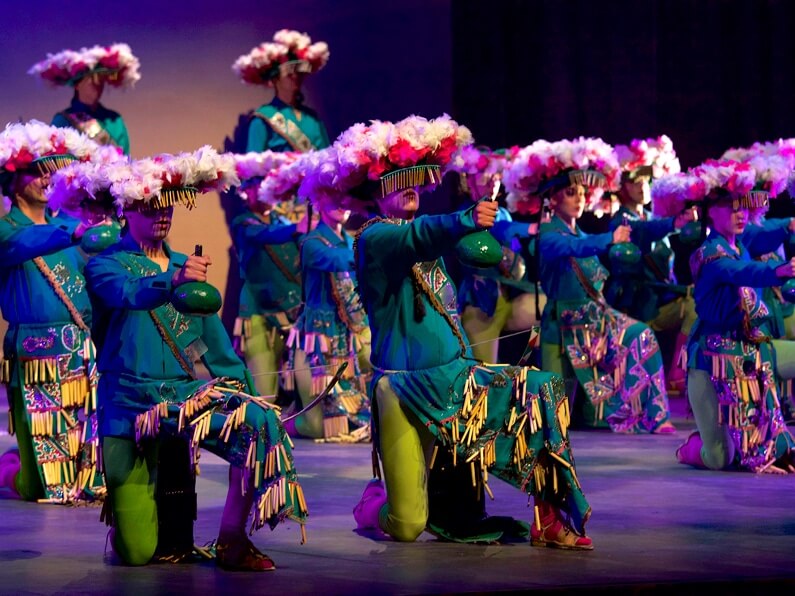
6. Catch a Performance of Mexico’s Ballet Foklórico at the Palacio de Bellas Artes, Mexico City
The Ballet Folklórico is a 3-hour performance incorporating dances representative of Mexico’s history, from the Aztec times all the way through to modern-day Mexico. You’ll be wowed with colorful costume styles, unique traditional dances, and incredible music. This is an interesting way to learn about Mexico’s history from a seat in one of the most beloved buildings in Mexico City, the Palacio de Bellas Artes. Click here to learn more and check ticket prices!
The Palacio de Bellas Artes is worth a visit regardless of whether you have a chance to see the ballet. Construction on the incredible building began in 1905 but wasn’t completed until 1934. The architecture style has neoclassical, art nouveau, and art deco influences and a facade of Carrara marble which is so heavy that the building has sunk approximately 4 meters since construction!
In addition to performances, the Palacio de Bellas Artes also features incredible works by some of Mexico’s most treasured artists, including the famed muralists Diego Rivera, David Alfaro Siqueiros, and José Clemente Orozco.
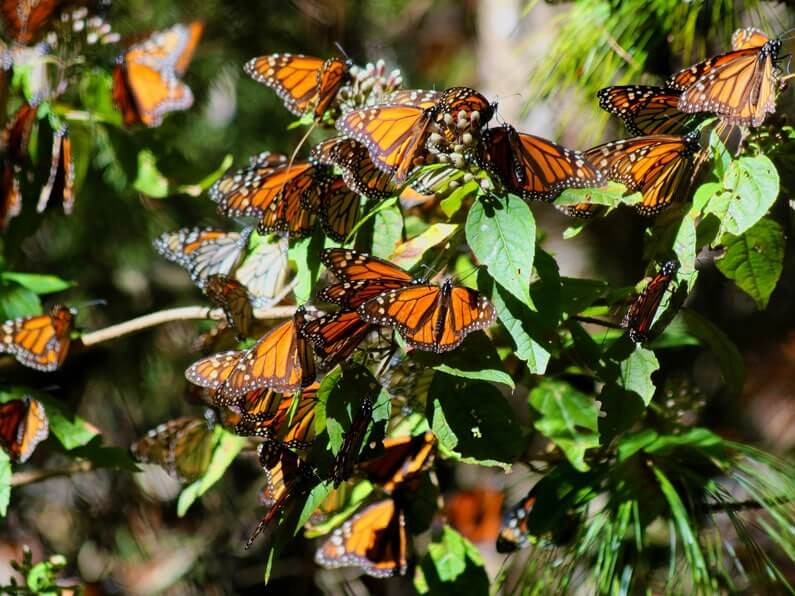
7. Mingle With Monarchs in the Monarch Butterfly Biosphere Reserve, Michoacan
From October to March, this reserve is home to millions of Monarch butterflies that migrate south to Mexico for the winter. What’s truly incredible about this migration is that it takes months to complete, despite the fact that the lifespan of a butterfly is a mere 2 to 6 weeks.
UNESCO recognizes the reserve as a World Heritage Site and seeks to protect it as an “exceptional experience of nature.” According to the UNESCO website, the number of butterflies is so prolific that their weight bends tree branches! Can you imagine?
Because the reserve sprawls along the border of the state of Michoacan and Mexico, there are access points from either state. Within the state of Mexico you can visit La Piedra Herrada or Cerro Pelón sanctuaries, while from Michoacan you can visit the El Rosario or the Sierra Chincua reserves.
I haven’t yet visited any of these sanctuaries (unfortunately!) but I’m keen to! My research has led me to think Sierra Chincua might be the ideal access point.
Regardless of where you choose to visit, you can mingle with the butterflies on guided hikes within the reserve. If hiking seems too strenuous (it can be steep, by the sounds of it) you can also opt to explore the area on horseback.
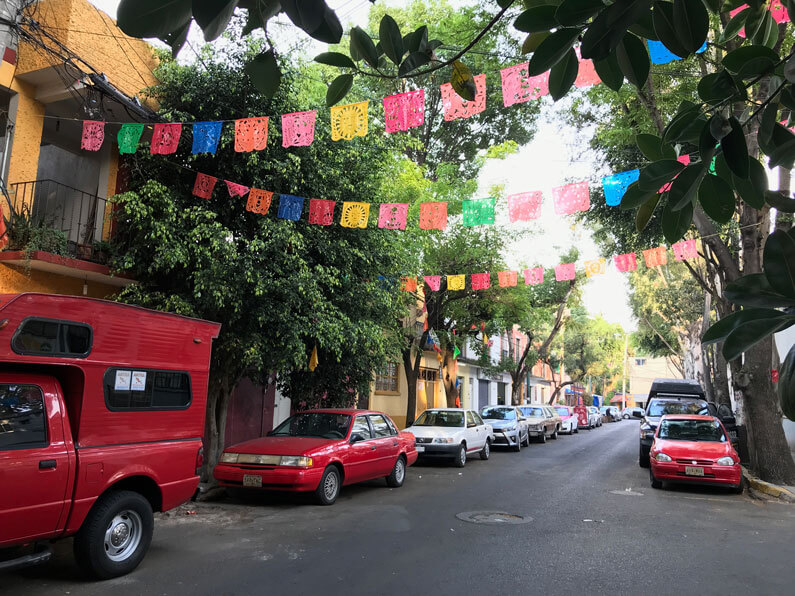
8. Visit Frida Kahlo’s Casa Azul in Coyoacán, Mexico City
Frida Kahlo’s famous Casa Azul was her childhood home, her residence with Diego Rivera, and has since been converted into a museum dedicated to her life and work. The house and grounds are beautiful in their own right, but the collection of art exhibited is striking.
My favorite part of the museum, personally, was the section dedicated to Frida’s outfits. It was fascinating to learn about the influences on her personal style, and why she chose to dress the way she did in order to conceal her imperfections and insecurities.
If you plan to go, book tickets in advance, or risk being turned away.
Arrive in Coyoacán early and spend a few hours wandering the colorful streets, visiting the market and the parks, and nibbling on tasty, authentic snacks in one of the many adorable cafes!
Related Reading: How to Spend 4 Perfect Days in Mexico City

9. Hang 10 in Sayulita, Nayarit
By Roxane of The Coastal Campaign
Coming from Canada, Mexico is a very common holiday destination for us. I have been fortunate enough to have visited on numerous occasions, and still to this date, one of my favorite activities is surfing in the small beach town of Sayulita.
This cute town with bright store facades, delicious restaurants, and picturesque little cobbled streets is adored by travelers worldwide for good reason. Just an hour’s drive north of Puerto Vallarta, it is well worth the trip. Not just a surfing town, Sayulita is home to many local artisans and trendy boutique shops, so make sure you take some time to pop your head into a couple of stores.
Once you are all shopped out, it is time to head to the beach. If you are new to the surfing realm, grab an instructor for an hour or two for an inexpensive lesson.
Or if you are feeling adventurous, rent a board from any of the local surf shops (it shouldn’t cost you more than $10 for an hour) and try your luck with a few waves! It is so much fun to get out in the water, either by yourself or with some friends, and do something active. There are few feelings as satisfying as catching a wave, standing up, and riding it to shore.
Once you have had your fill of the waves, make sure you grab a cold drink on the beach – you’ve earned it!
Dreaming of the beach? Check out my guide to Mexico’s best beach towns!
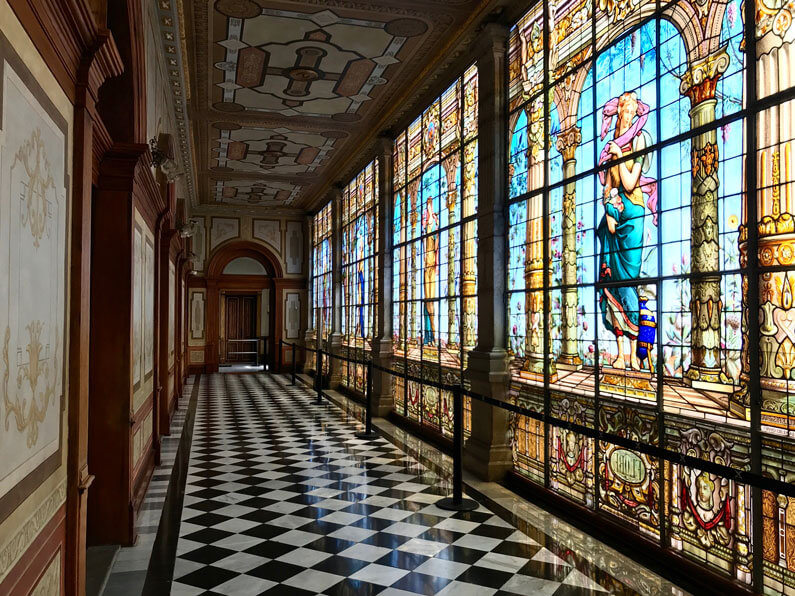
10. Soak Up History in the Museums of Mexico City
If you’re a history lover Mexico City is an essential spot for your Mexico bucket list. There are a plethora of museums to be discovered, covering all kinds of topics. From the Museo Nacional de Antropología, which houses artifacts from pre-Hispanic times, to the Museo Casa de Luis Barragán, which displays works from the award-winning architect in his former home, you’re bound to find something of interest!
Of course, don’t forget to visit the Palacio Nacional to discover the history of modern Mexico, and visit the famous Diego Rivera murals which showcase the Spanish conquest. And no trip would be complete without a stop at the Castillo de Chapultepec. This palace was originally constructed as a summer home for the viceroy of Spain but now serves as the National History Museum of Mexico.
If you’re an art lover, the Museo Soumaya holds the private collection of Mexican business magnate, Carlos Slim. Here you’ll find works by everyone from European Avant-Garde painters to contemporary Mexican artists and beyond! These options are just the beginning, there’s still plenty more to be discovered depending on your preferences!
Dreaming of Mexico City yet? These charming Mexico City vacation rentals would be the perfect base for your trip!

11. See Baby Turtles Released in Puerto Vallarta, Jalisco
By Helen of Helen on Her Holidays
One of the most special experiences I’ve had in Mexico took place on a beach just north of Puerto Vallarta. One evening, just before dusk, we stood outside the Nuevo Vallarta Turtle Sanctuary, where in just a few minutes, a nightly event would begin.
At dusk, the gates of the sanctuary opened and two volunteers came out carrying a large plastic box. We peeped over the edge to see that it was full of tiny baby turtles – Olive Ridley turtles – who’d hatched earlier that day. Their mothers had come to the beach a few weeks before to lay their eggs, which had then been brought into the safety of the sanctuary to incubate. Now it was time for the babies to take their first steps in the wild.
We weren’t allowed to touch the little turtles but the volunteers did tell us all about them. They release the young turtles at dusk as that’s the safest time, with fewer predators and more chance that they’ll reach the water safely.
After doing a final check for any turtle-eating birds in the area, the volunteers gently took them out of their plastic tub and placed them on the sand, quite a way from the water’s edge. It’s important for the young turtles to find their own way to the ocean so they have time to feel and taste the sand, helping them to find their way back to lay their own eggs. We watched them rush towards the water to begin their lives in the sea – a magical moment and an unforgettable experience in Mexico.
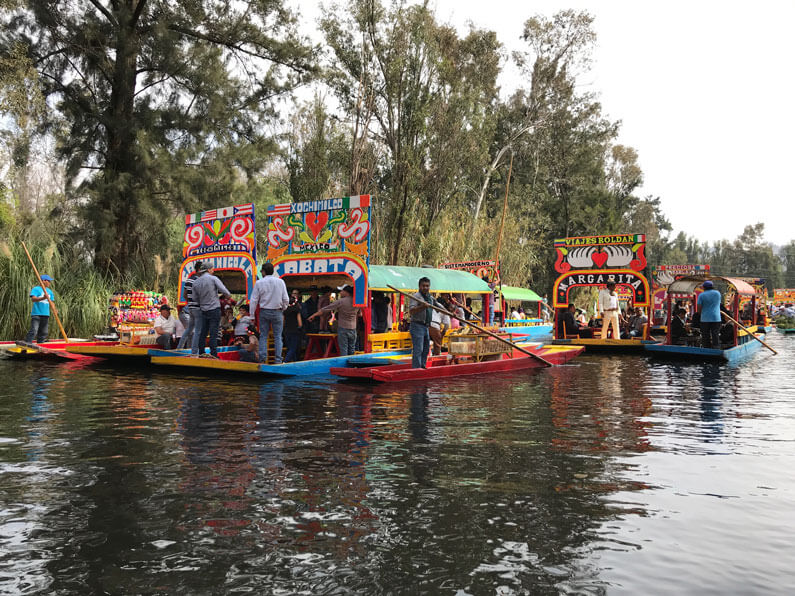
12. Cruise the Canals of Xochimilco, Mexico City
To cruise in a trajinera (a colorful boat) through the canals of Xochimilco is, without a doubt, an activity that anyone who wants to learn more about Mexico and the country’s traditions should do. A Xochimilco tour will leave you absolutely soaked in Mexican culture.
Along the way, you will be surrounded on all sides by music of every type, from the traditional mariachi and fandango styles up to Norteña bands! For a small tip, a band will serenade you with the musical stylings of your choice! Meanwhile, on the other side, you will be bombarded with options of delicious comida típica, from tacos to elotes, nopales, and antojitos!
Xochimilco is popular among tourists and locals alike who wish to spend a few hours relaxing while surrounded by a unique landscape with a friendly ambiance. These canals were part of a network of waterways within the Lake of Texcoco.
Historically, these served the Aztecs not only as routes for transporting goods but were also developed for a particular form of agriculture in which crops were grown on man-made, floating islands. The city of Tenochtitlán (now Mexico City) was built on an island in the middle of Lake Texcoco, surrounded by canals.
The borough of Xochimilco is all that remains of what used to be the main method of transportation. While lazy voyages on the canals are a fun pass-time, many residents of this neighborhood still use these waterways as routes for commuting to school, work, and beyond!
One piece of sage advice: go easy on the Tequila while singing Juan Gabriel songs at the top of your lungs… it could be a recipe for disaster while on a boat, in constant motion. Just sayin’!
Southern Mexico
Southern Mexico includes the states of Campeche, Chiapas, Oaxaca, Puebla, Tabasco, Quintana Roo, Veracruz, and Yucatán.
Though it covers only a handful of states, this region is home to some of Mexico’s most popular destinations, namely those of the famous Yucatán peninsula. From the colorful, colonial streets of Oaxaca City, the lush jungles of Chiapas, and the white sand coasts of Quintana Roo, there is a lot to take in!
Following are just a few of the unforgettable experiences that you might wish to add to your Mexico bucket list.
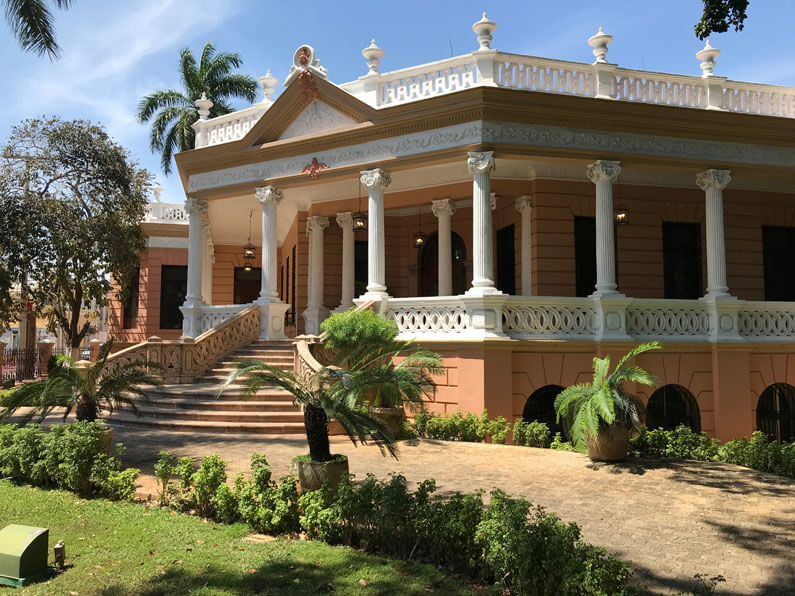
13. Eat Cochinita Pibil in Merida, Yucatán
Cochinita pibil is a style of slow-roasted, marinated pork that originates from Yucatán state. Traditionally this dish is prepared by roasting for hours on a bed of hot coals buried underground. After a fitting amount of time the tasty meat is dug up and served. However, I’m sure this technique is no longer the most common method of preparation.
The marinade used on the pork is a delicious citrus concoction that tastes absolutely heavenly. You can put the cochinita in tacos, a torta, enjoy it alongside scrambled eggs, or in a myriad of other presentations.
While I think it’s totally reasonable to visit Merida solely to eat cochinita pibil, I would also recommend exploring the city. It’s one of Mexico’s most beautiful colonial cities and offers some of the country’s very best food.
Be sure to drive down the Paseo de Montejo to spot the impressive, French-inspired 19th-century mansions that line the street. You may also wish to check out the Gran Museo del Mundo Maya, visit a few cenotes, or even take a road trip to Chichén Itza!
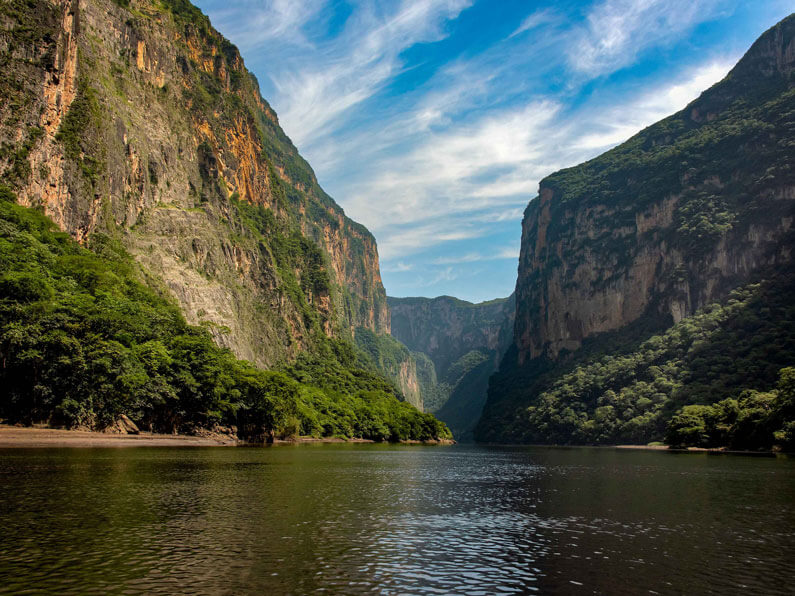
14. Ride A Boat Through Sumidero Canyon, Chiapas
The state of Chiapas is an outdoor lovers’ paradise. While there are countless nature-oriented experiences to be had, the Cañón del Sumidero is definitely one of the most popular and impressive things to do in Chiapas.
One of the best ways to experience the canyon is on a boat ride that departs from the town of Chiapa de Corzo. As you skirt along the Grijalva River, the steep canyon walls tower up to 2500 feet above you. If you’re staying in San Cristobal de Las Casas, you can book tours to Sumidero Canyon that depart right from San Cris.
Watch for wildlife as you cruise: you’re liable to spot crocodiles and many different species of birds. The canyon also offers impressive geological features, like stalactites, caves, sections of rapids, and seasonal waterfalls!
Later, back on land, don’t forget to sample the famous Chiapas coffee as you reflect on the day’s adventure!

15. Hike in Itza-Popo National Park, Puebla
Iztaccíhuatl and Popocatépetl are neighboring volcanoes and the second and third tallest peaks in Mexico. They can often be spotted in the distance if you are within Puebla or Mexico City.
A day hike in the National Park sounds like an exciting trek and a fun way to get a closer look at these two volcanoes. Popo is an active volcano and you may even see her spew ash during your hike!
Dan and Di of Slight North have a great guide on how to spend a day hiking in Itza-Popo National Park, and I can’t wait to put their advice to use!
If you’re a more intrepid explorer, there are numerous mountaineering expeditions that you can join in order to climb Iztaccíhuatl. If you prefer a solo mission, you can hire a guide to take you up.

16. Sail the Lagoon of Seven Colours in Bacalar, Quintana Roo
By Felicia of Feather and the Wind
There are dozens of charming pueblos magicos worthy of a spot on your Mexico bucket list and Bacalar is one that ought to be close to the top. Nestled in the south of Mexico, not far from the Belize border, the town of Bacalar is a perfect destination for those looking to escape the crowds of more popular tourist hot spots.
Sometimes referred to as the Maldives of Mexico, Bacalar’s stunning lagoon has so many shades of blue that it just might take your breath away when you first catch sight of it. The appropriately named Lagoon of Seven Colours can be admired from a waterfront bar, dock, or hammock but the best way to experience this hidden gem in Mexico is with a memorable sailing excursion.
Enjoy the lagoon’s endless blue hues as you make your way toward the Pirate Channel where you can stop for a refreshing dip in the clear, shallow water. Your sailing trip will likely also feature bird watching, a visit to the Black cenote, and a lesson on the stromatolites that make this lagoon so unique.
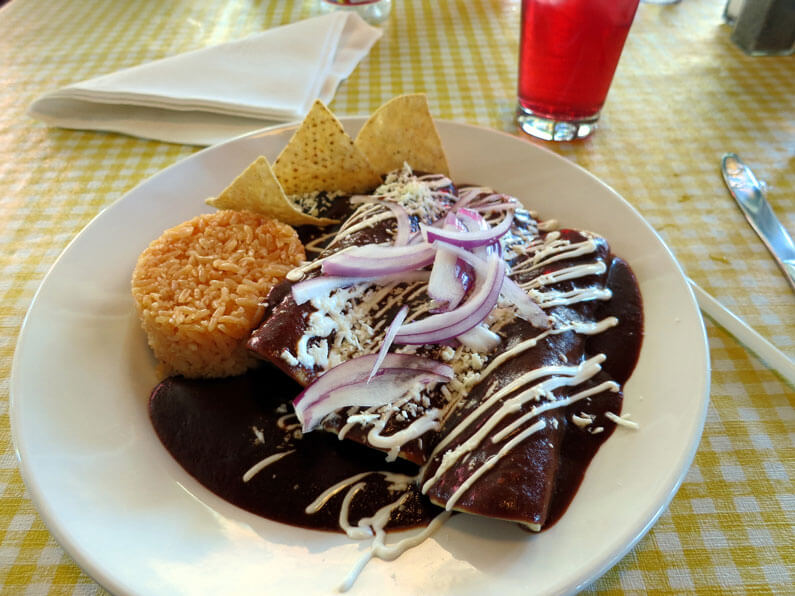
17. Eat Mole Poblano in Puebla City, Puebla
I was intrigued when I heard that mole poblano was a chocolate sauce. I’ve never met a piece of chocolate I didn’t like. I mean, I literally have no standards (or self-control) when it comes to chocolate. But, when I learned that it’s usually served over meat I became skeptical. If you’ve never tried it before it’s hard for your palette to anticipate what such a concoction would taste like.
Spoiler alert: Incredible.
And I’m not just saying that because I’m a chocoholic. In fact, it took me years to really develop a taste for mole, but now… I’m obsessed.
While it’s commonly found throughout Mexico, mole poblano is believed to have originated in Puebla. It consists of chocolate, chili, and approximately 20 other ingredients. It’s typically served over meat or as an enchilada sauce. If you visit Puebla (or anywhere in Mexico, really) you’ll be missing out if you don’t try this tasty and unique dish. It’s possible you may not like it the first time (I didn’t), but I urge you to give it at least 3 tries before you abandon the idea — it tastes different everywhere you go!
If you love mole poblano and wish to experience some of Puebla’s other traditional offerings, try ordering a cemita poblana or chiles en nogada! A cemita is Puebla’s version of a torta: a sandwich on a fluffy roll stuffed with meat, cheese, avocado and veggies!
Chiles en nogada consists of a poblano chile stuffed with ground beef and veggies (picadillo), bathed in a creamy nut sauce, and topped with pomegranate seeds. This dish is most popular in the late summer when pomegranate seeds are in season.
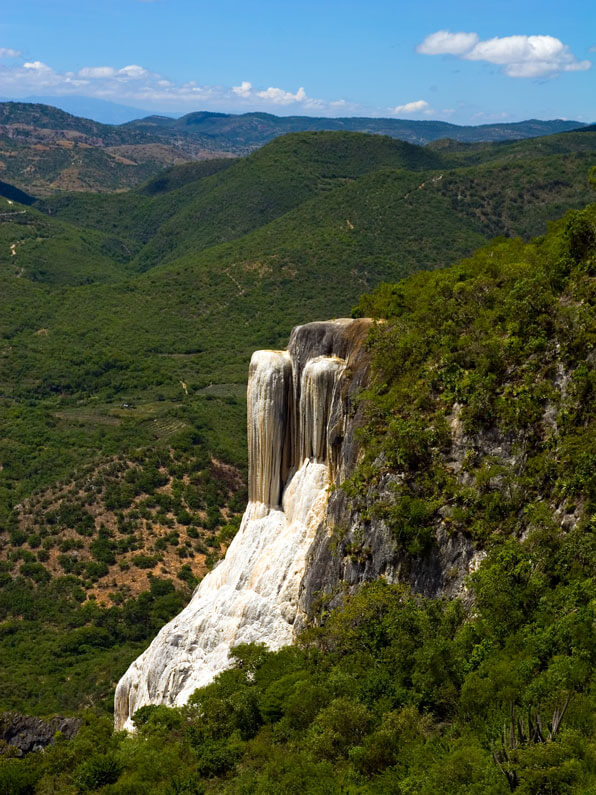
18. Photograph the Hierve El Agua “Waterfall” in Oaxaca
This calcified “waterfall” near the city of Oaxaca is formed from water oversaturated with calcium carbonate. After many long years of dripping from the earth, it has hardened into a “frozen” cascade that drops over 50 meters into the valley below.
The name of this site is a bit of a conundrum to anyone who speaks Spanish, as hierve means “boiling.” The “boiling water” the name refers to is actually the heavily carbonated water that is being pushed from the earth’s surface. There are pools of this water at the top of the site that are said to be swimmable!
Hierve el Agua is just one of many amazing things to do in Oaxaca. I can’t wait to see it for myself one day!
Related Reading: How to Spend 4 Amazing Days in Oaxaca, Mexico

19. Soak up the sun in Tulum, Quintana Roo
By Greta of Greta’s Travels
If you’re looking for the ultimate Mexico travel experience you have to add Tulum to your bucket list. Tulum is a town along the coast of the Yucatan Peninsula, in the state of Quintana Roo, famous for its white-sand beaches with turquoise water and the well-preserved Mayan ruins that overlook them.
The beach by the ruins of Tulum is very beautiful and you will most likely see lots of people swimming in the sea and enjoying the beach, but the real highlight for me was the Mayan ruins. Walking through the remains of this ancient civilization in such a beautiful natural scenario will amaze you. Tulum becomes very busy during the day so try to get there early if you want to beat the crowds.
Once you’ve had enough of history there is more to explore in Tulum than just beaches and Mayan ruins. You can venture inland to swim in the cenotes (natural sinkholes resulting from the collapse of rock that exposes underground water) or go scuba diving in the sea searching for turtles. Tulum is a beautiful part of Mexico, which I believe everyone should add to their Mexico bucket list.
Read Also: 18 Adventurous Things to do in the Riviera Maya
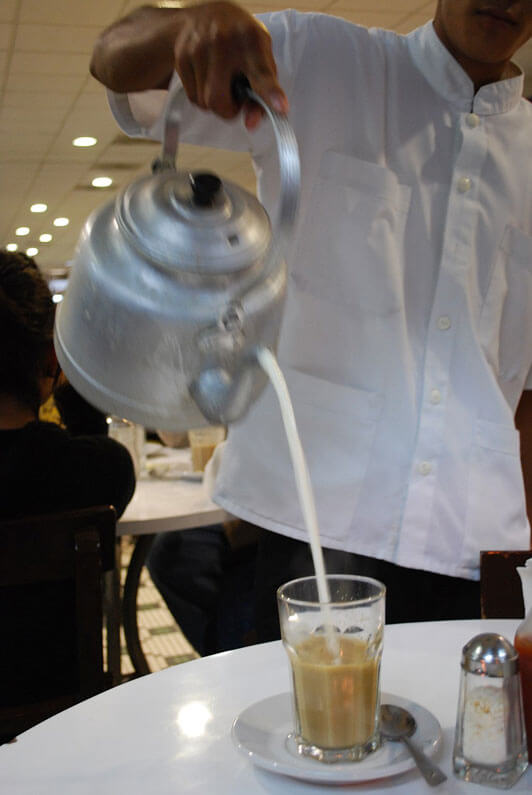
20. Enjoy a Lechero at La Parroquia in Veracruz City, Veracruz
Drinking a lechero in the Gran Café de la Parroquia has been, for many years, a tradition that is practically obligatory for anyone who visits the Port of Veracruz. The waiter will bring you a tall glass with a shot of espresso and bang a spoon against the glass, signaling another waiter to serve the milk.
When the second waiter arrives he will complete your delicious coffee by making a show of pouring the milk into your glass from up to a meter above! This tasty, traditional coffee is made complete when accompanied by a bomba, a sweet bread with butter inside.
As you enjoy the breeze floating in from the Gulf of Mexico, you can listen to traditional music in the Huapango Jarocho style, which originates in Veracruz. Many people overlook the fact that it was in this very city and this style that the famous song “La Bamba” was written!
Ritchie Valens may have made it famous worldwide, but this song has long been considered a Veracruzan hymn and even has its own accompanying dance!

21. Swim with Sea Turtles in Akumal, Quintana Roo
The beach town of Akumal sits right between Tulum and Playa del Carmen in the Riviera Maya. Not only is Akumal one of the most beautiful beaches in the area, but it’s also the feeding and nesting ground of four different species of sea turtles. If you take your own gear (or hire a guide) you can snorkel with turtles right from the beach!
For the best experience, plan to arrive at Akumal Bay early in the day before the sandy bottom is disturbed, making visibility poor. Spend a few hours snorkeling with the turtles and then relax with a picnic on the beach! Later, after a couple of cervezas, head out for another round of snorkeling, or just enjoy a peaceful swim in the warm water!
Curious to visit? Read my full guide on snorkeling with turtles in Akumal.

22. Frolic in the Water at Xel-Ha, Quintana Roo
By Sara of Fernweh Sarah
Already before we started on our nine-month trip around the world, a colleague insisted that Xel-Ha in Tulum, Mexico absolutely has to be on our world travel bucket list. A few months later, we spent a day at Xel-Ha – and I now understand why she was so excited about it!
Xel-Ha is an all-inclusive water park 20min by car from Tulum. You can get there with an organized tour or simply by using one of the small public busses (my recommendation!). The public busses will drop you off near the highway and you then simply walk for about 5min to reach the entrance of the water park.
Inside Xel-Ha, tubing through a mangrove river, numerous waterslides, ziplines, cenotes, and other fun water adventures await you. Almost everything is included, right in the beginning, you will get your personal snorkeling set (mask, disposable snorkel, fins) as well as towels and a swim west. There are lockers for your personal stuff like clothes etc. too.
And now the best: Food and drinks (even cocktails) are included in your day pass as well! (This is not the case with the sister park Xcaret near Playa Carmen!). We were very pleased by the food selection and quality – the best choice in our opinion was the Mexican Restaurant (La Cocina del Pueblo).
The only things that cost extra are things like StingRay Encounter and SNUBA Diving – but we were waaaaay too busy with the free stuff to try any of those! Just bring your GoPro and prepare for a day full of splashing in fresh and saltwater, snorkeling, and enjoying the amazing Mexican waterworld!
Read Also: 10 Thrilling Playa del Carmen Day Trips
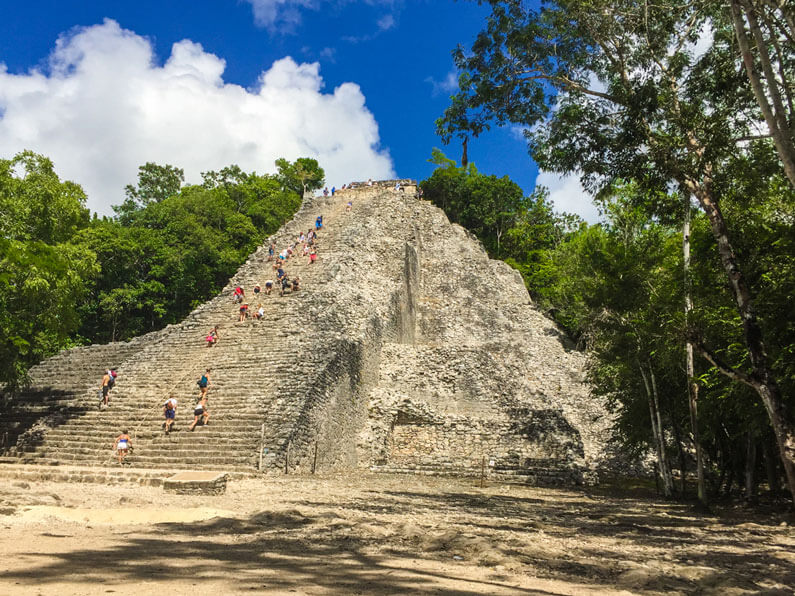
23. Scale the Coba Pyramid, Quintana Roo
By Alina of The Happy Kid
Coba is a bit remote from the coast and not as famous as other Mayan sites in the Yucatan peninsula. Which is why you will enjoy it even more, without huge crowds and souvenir vendors! Probably it is also the reason why you are still allowed to climb on the Nohoch Mul pyramid, the main temple in Coba. 42 meters in height, this is one of the tallest Mayan pyramids.
It is quite an adventure to climb the 130 stairs to reach the top, very steep and slippery from thousands of people that climbed them over time. Even if it sounds strange, the way back down is even more challenging, due to the inclination.
But do not worry, the view is totally worth the intense workout. The site is surrounded by jungle and lakes, offering a stunning panorama. Some even say there still are ruins hidden in the lush vegetation, not yet fully explored. Just make sure you have plenty of water with you, the sun seems to burn even more on the top of the pyramid.
The Coba ruins are spread over quite a big site. You can walk through the jungle from one complex to another, but it is better to take a bike or a tricycle taxi. You’ll enjoy it much more and you’ll preserve your energy for the pyramid.
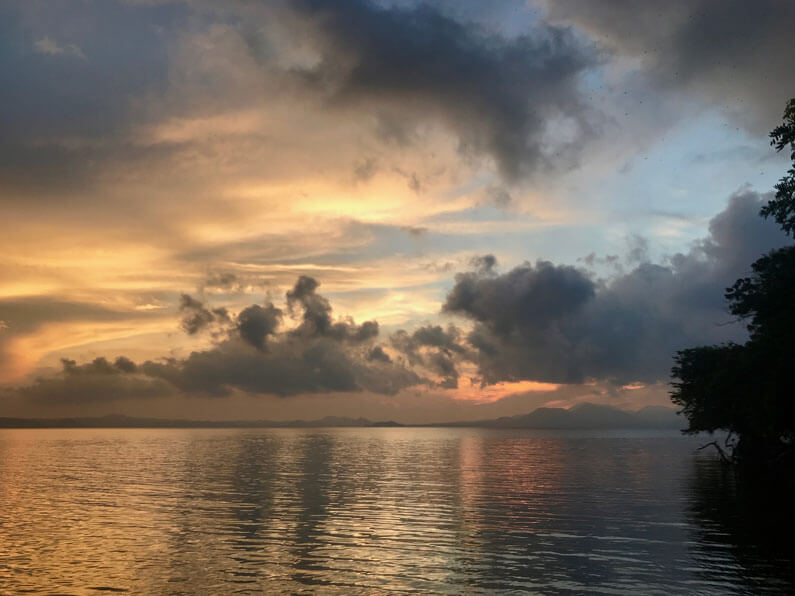
24. Find Peace Among Nature at the Laguna de Catemaco, Veracruz
The Laguna de Catemaco is, without a doubt, a magical place reserved for only the most adventurous. Along its 12 miles (19 km) of width you will encounter a paradise “from the movies.” … Literally though, this location was the backdrop of Mel Gibson’s controversial film, Apocalypto. This area is known worldwide for its resident brujos (witches) and spiritual cleansing rituals, both of which attract thousands of visitors annually.
Located in the south of the state of Veracruz, within the Los Tuxtlas jungle, this enormous lake possesses a unique beauty. It is surrounded by the Sierra Madre mountain range and sits 400 meters above sea level.
In the middle of the jungle, looking toward the lake, you will find the ecological reserve of Nanciyaga. Here you will find a sanctuary protecting the area’s species, including animals and plants. It also offers lodging in cabins and the opportunity to partake in a popular mud bath ritual.
If you choose to venture onto the lake, you will find an island filled with white Crane birds (Garzas), referred to as La isla de Garzas, where hundreds and hundreds of these birds reside on the branches of the trees, turning them white.
Further along the lake you will find La isla de Changos. These changos, a special species of Macau hailing from Asia, were introduced to the zone by the University of Veracruz as part of a study of adaptive evolution. Surprisingly, the monkeys mastered the art of fishing and swimming in order to survive.
You will also spot beautiful mangroves which many people enjoy exploring by kayak or canoe. If you’re lucky (or organized) enough to do this during sunset, you will be sure to have one of the most magical viewpoints as the sun sinks between the mountains. Without a doubt, this is something you won’t want to miss!
Related Reading: 23 Incredible Off-the-Beaten-Path Destinations in Mexico
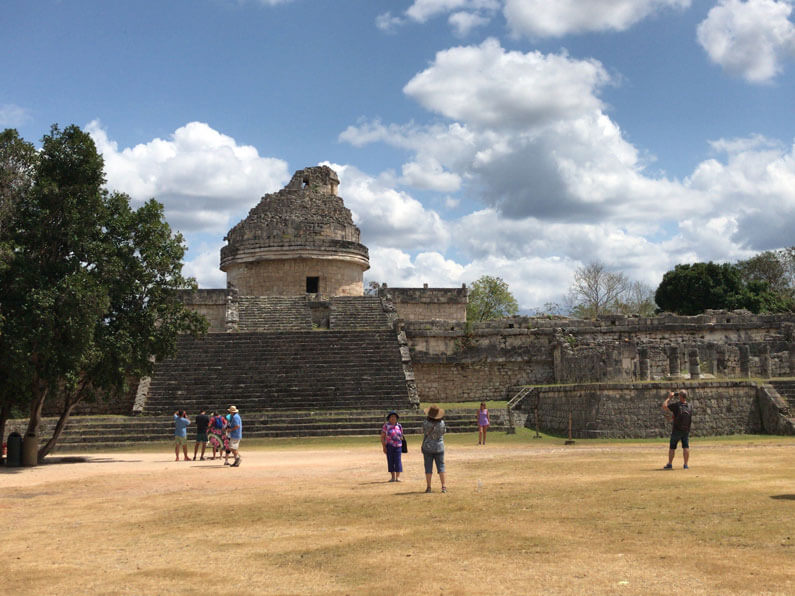
25. Visit the Pre-Columbian City of Chichen Itza, Yucatán
The Mayan ruin of Chichen Itza is located on the Yucatán peninsula and makes a great day trip from Cancun, the Riviera Maya, or Merida. It has recently been designated one of the NEW 7 Wonders of the World and has been a UNESCO World Heritage site since 1988. It’s one of the most popular tourist attractions in Mexico, and for good reason. History aside, it’s a visual marvel (though, I highly recommend reading about the history as well).
There are many incredible structures at this site, the most notable being El Castillo pyramid. A quick search for Chichen Itza on Instagram will reveal endless photos of this pyramid, but my favorite structure is El Caracol — it’s totally different from the rest.
The site also features a dramatic cenote, and a juego de pelota (ancient ball game) court— how the players managed to get the ball through that tiny circle is beyond me!
After a day of exploring the ruins, plan a detour to a nearby cenote (Ik Kil is a popular choice) to cool off in the refreshing water.
For more Mexico travel inspiration, check out these posts:
What’s on YOUR Mexico bucket list? Let me know in the comments.
Love this post? Pin it for later!
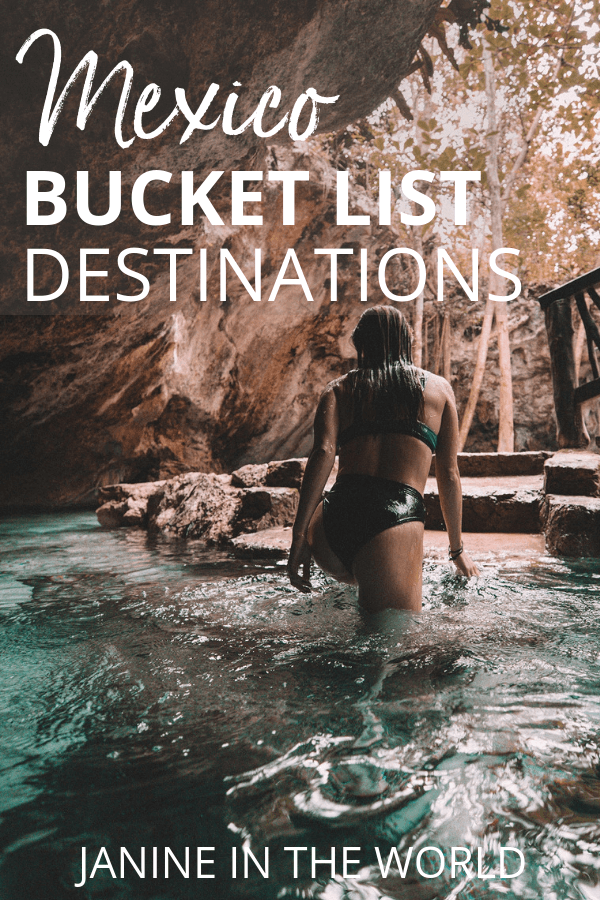
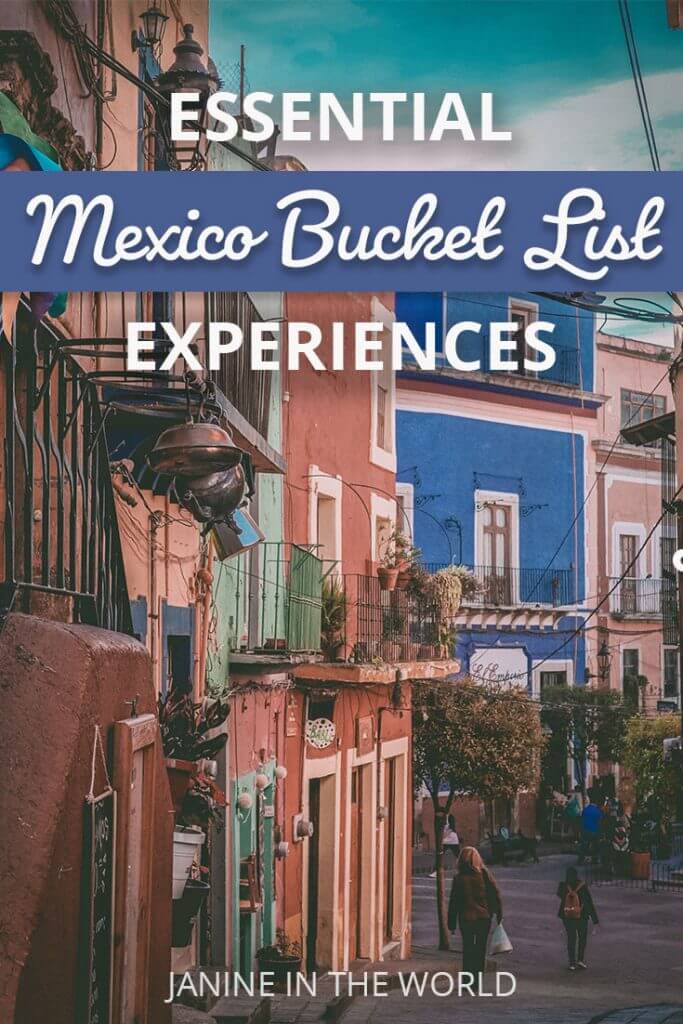
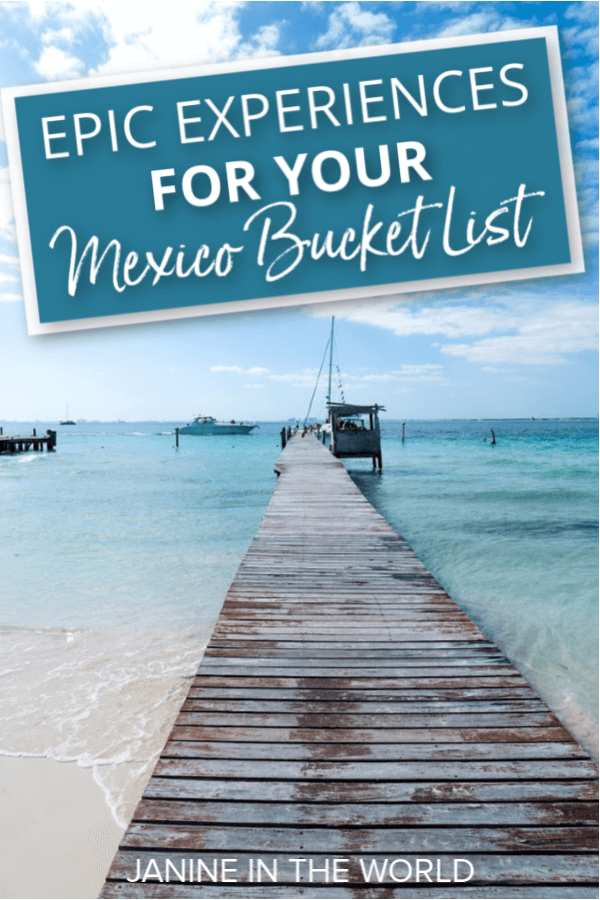





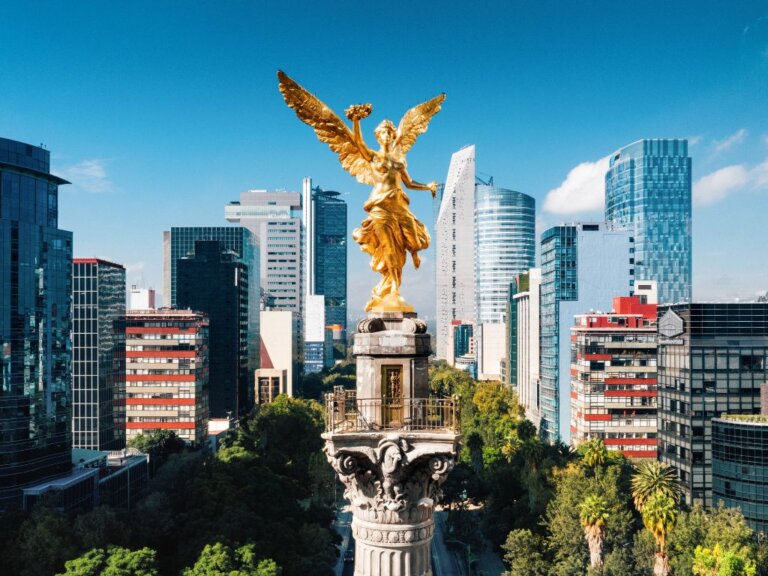
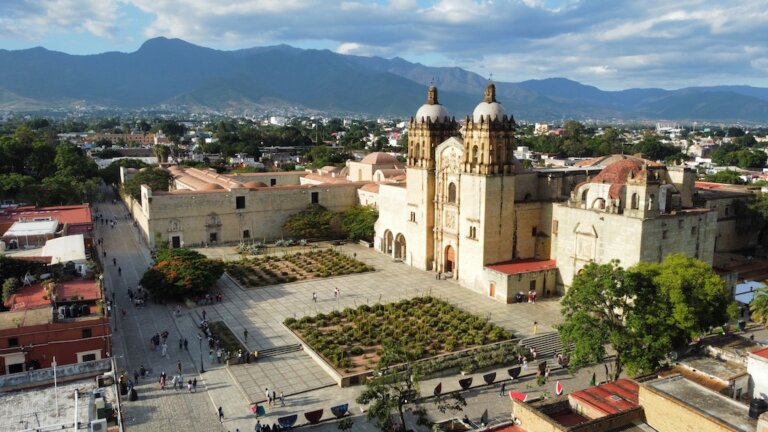
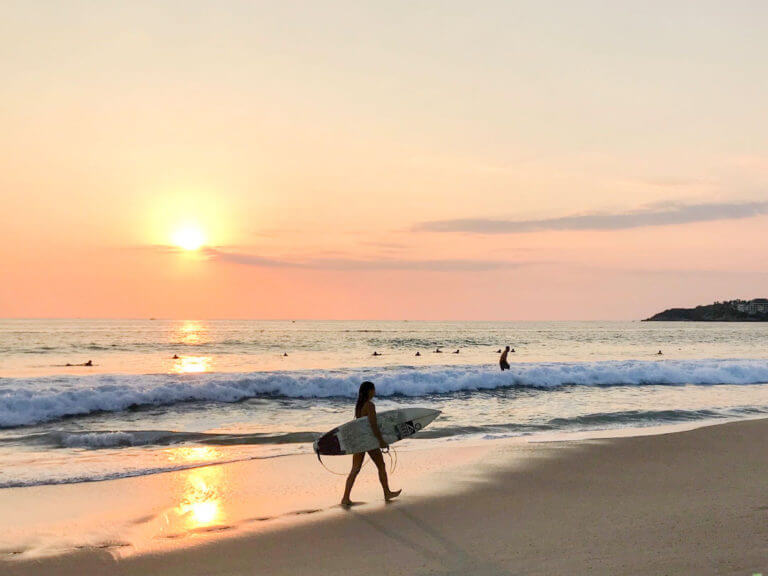
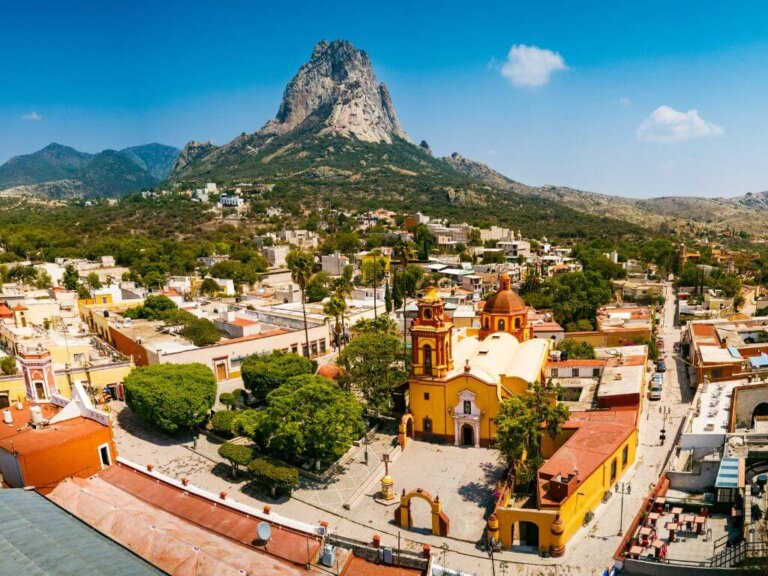
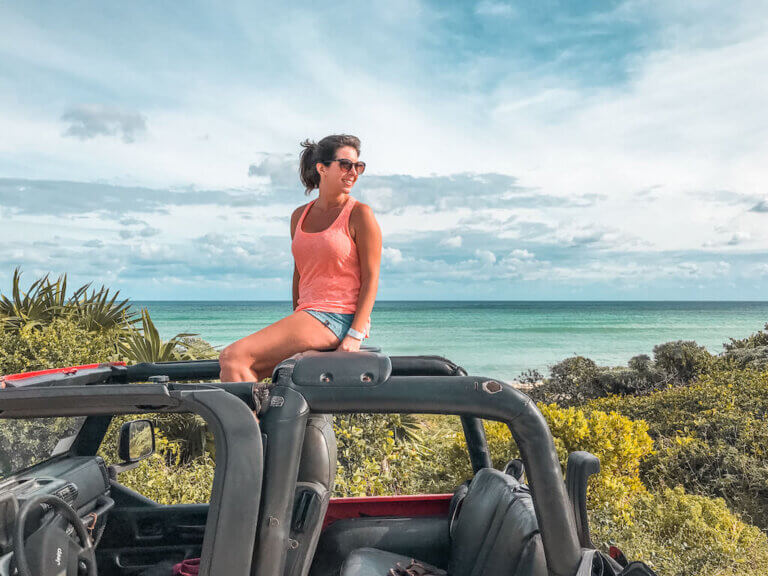
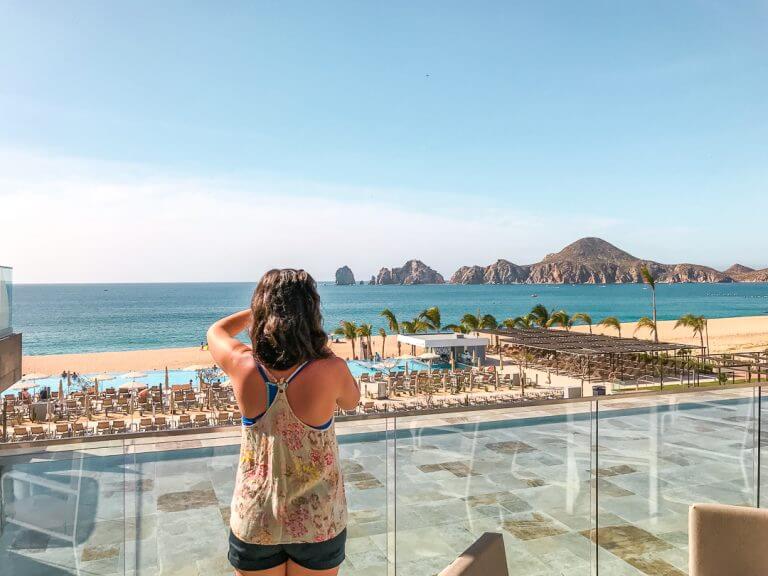
I think you did a great job composing this list! Definitely will remember checking it once I get to Mexico the next time! 🙂
Thanks Sarah! I hope you make it back soon!
Sadly I haven’t been to Mexico yet (well, not proper…only a few border towns) and this post definitely has me kicking myself. I knew there was some gorgeous natural scenery in the country, but several of those places bowled me over. I’ll be working harder to get there now. Thank you for putting this post together and for sharing the inspiration!
I’m so glad it left you feeling inspired! There’s certainly tons to explore — I even have a growing list of things to add to this post! I hope you get the chance to visit soon! Thanks for your comment 🙂
This is such an amazing list! I absolutely loved Mexico, we had 10 days there and it was nowhere near enough. There is so much to do and see, I’d love to go back! I especially want to see the release of the sea turtles in Puerto Vallarta!
It never feels like you have enough time, does it?! I live here and I still don’t feel like it’s enough! The sea turtle release certainly does sound magical!
Thanks for your comment 😀
WOOOW!!! So amazing! I fell in love with Mexico the last time I visited and cannot wait to go back. Will definitely keep this in mind when planning my next, hopefully, longer trip there.
Yay! I love taking long, slow trips! I feel like you get a much better sense of the place and the culture before you have to leave. I hope you can come back soon! Thanks for commenting 😀
Mexico is such an amazing place! I just visited Mexico City and renting a boat in the canals of Xochimilco was one of my favorite experiences ever! I will have to add these other incredible experiences to my bucket list as well!
Xochimilco is SO fun, isn’t it?! Mexico City is amazing but it can be pretty intense and I think Xochimilco is a great way to work some relaxation into the trip! Glad you feel inspired! thanks for your comment 🙂
Fantastic list – I’ve done some of these amazing things – Sumidero Canyon was probably my favorite – but you’ve definitely added a few experiences to my bucket list! I’ve always wanted to ride the Copper Canyon train. Thanks for a great post!
Thanks so much! I’m dying to see Copper Canyon too, it sounds amazing!